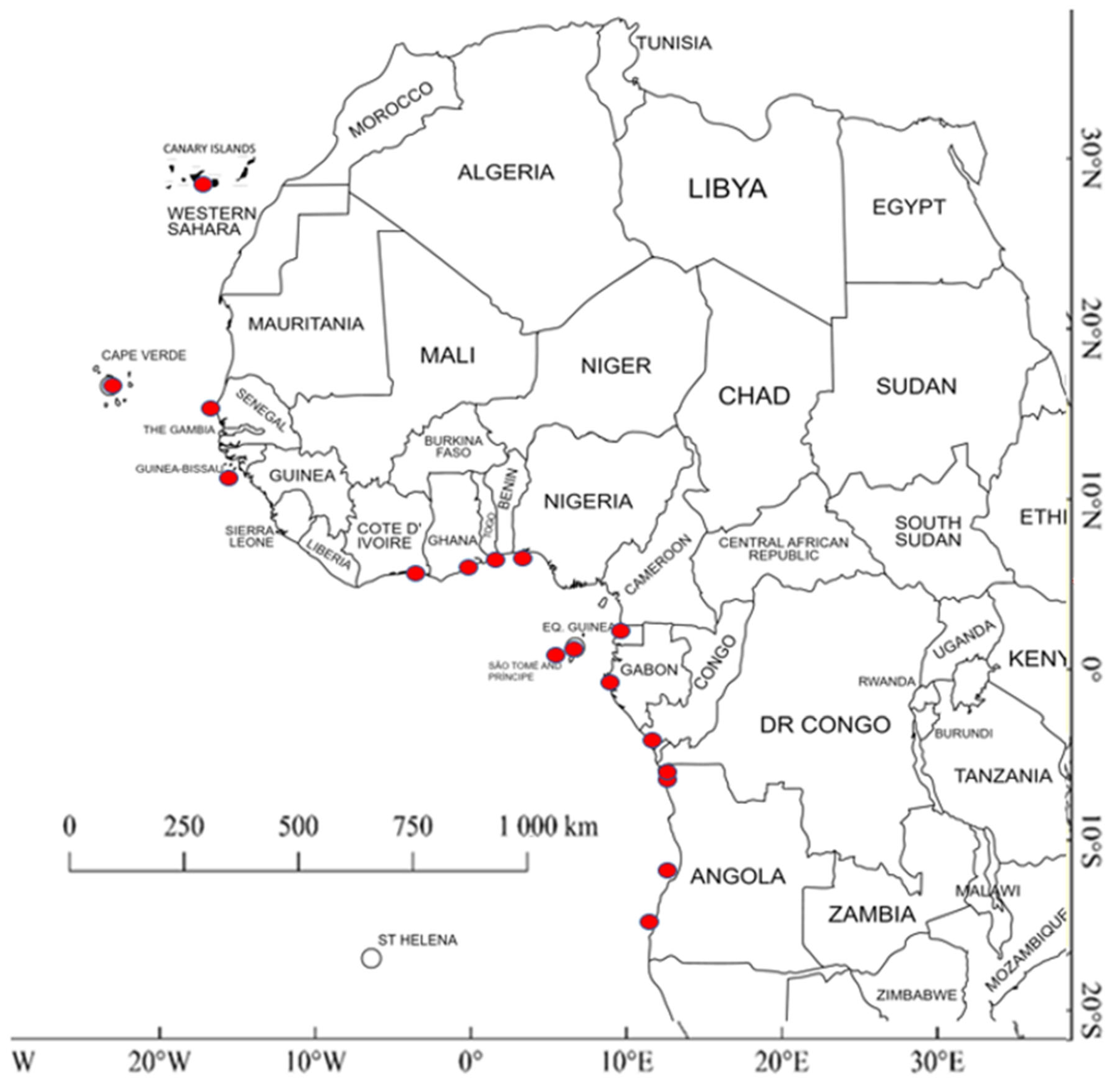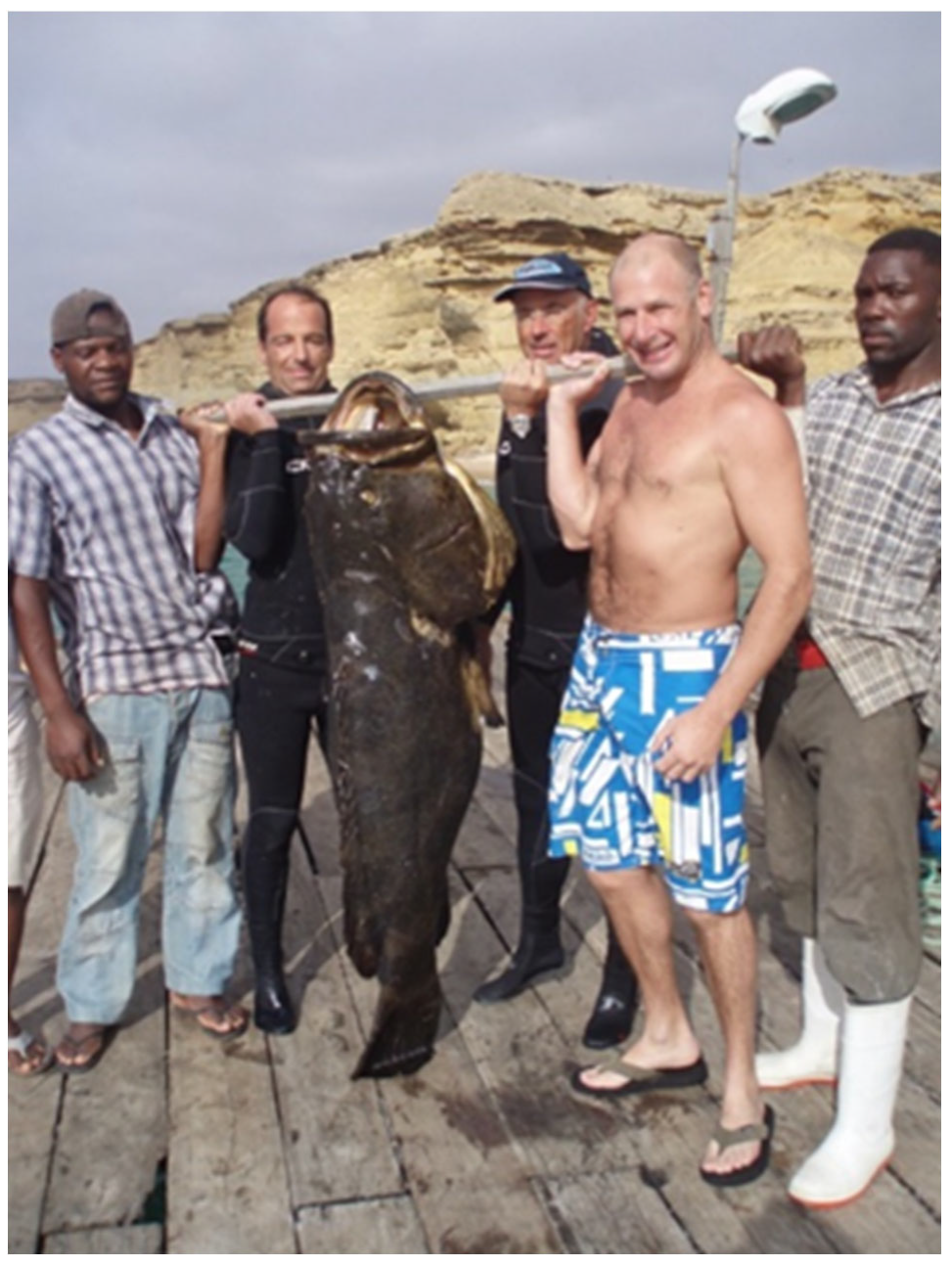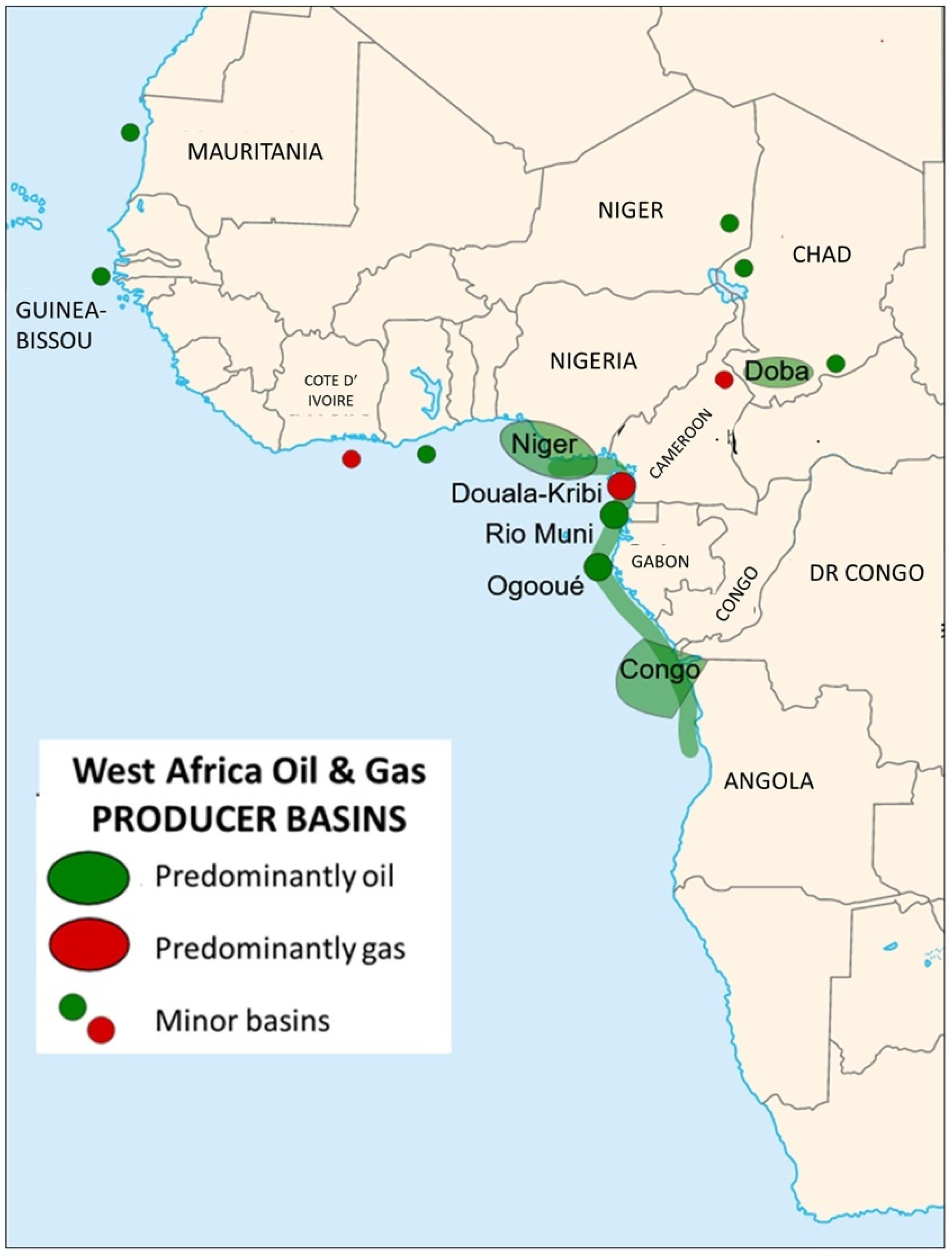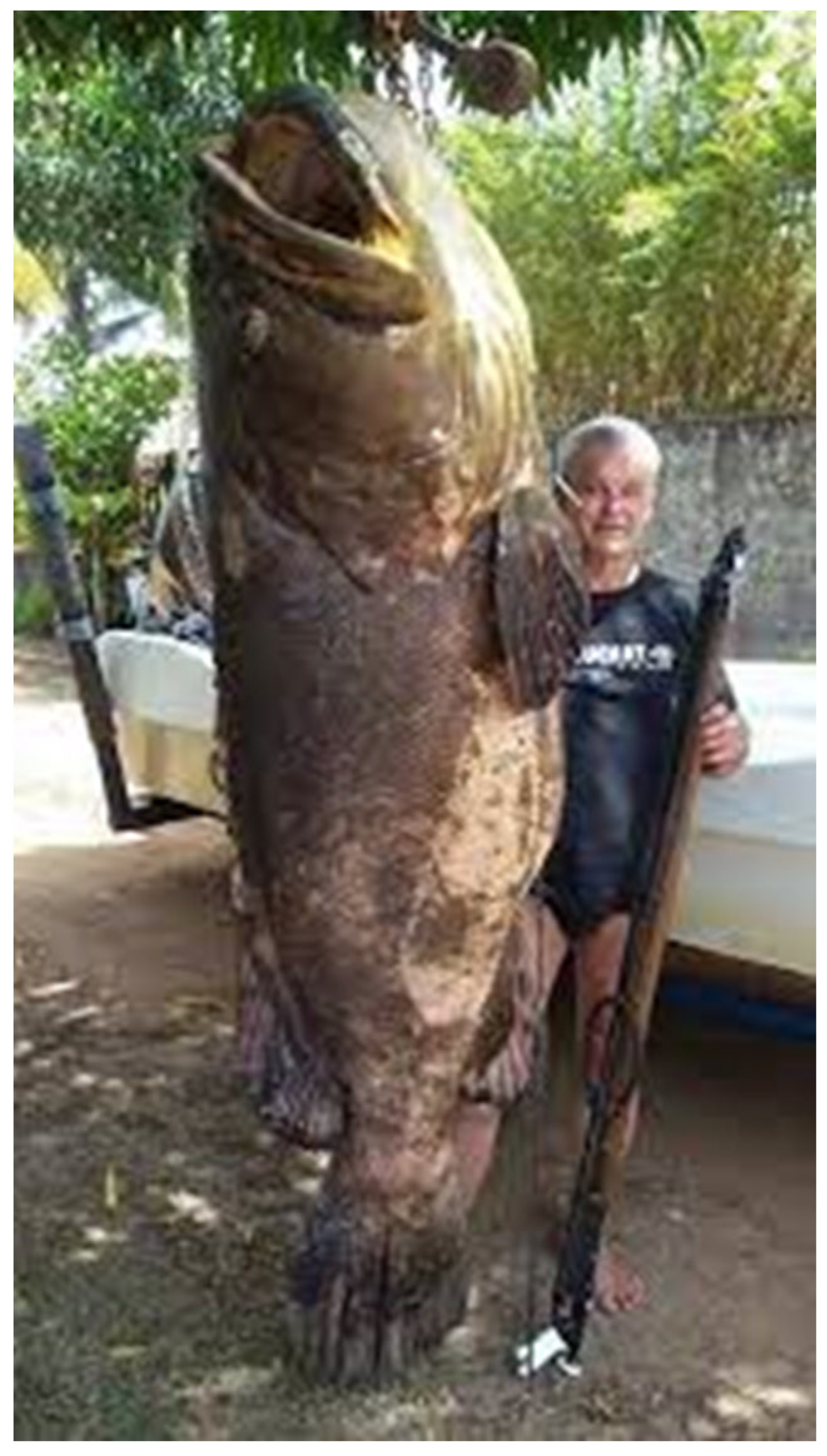West African Goliath Grouper: Where Are They between Senegal and Angola?
Abstract
1. Introduction
2. Material and Methods
3. Results and Discussion
3.1. Summary of Anecdotal Information
| Location | Population Status | Dates | Source |
|---|---|---|---|
| Canary Islands | Vagrant | 2002 | Brito et al., 2002 [12] |
| Cape Verde | Vagrant | 1989, 1994, 2019 | Trustworthy Pers. Comm. |
| Senegal | Rare | 1993 | Trustworthy Pers. Comm. |
| Guinea-Bissau | Rare | 2002 | Reiner 2002 [14] |
| Guinea | Rare | 2009 | Trustworthy Pers. Comm. |
| Côte d’Ivoire (Ivory Coast) | Rare | 1989, 1996 | Rampal 1989 [15] Trustworthy Pers. Comm. |
| Ghana | Rare | 2012 | Trustworthy Pers. Comm. |
| Togo | Rare | 2012 | Trustworthy Pers. Comm. |
| Nigeria | Rare | 2012 | Trustworthy Pers. Comm. |
| Equatorial Guinea | Rare | 2009, 2015 | Trustworthy Pers. Comm. |
| São Tomé & Príncipe | Rare | 1989, 2009, 2015 | Pers. Obs. JPB (visits to fish markets and dive sites) |
| Gabon | Common | 1989, 2009, 2015 | Berry, 1989 [16] Pers. Obs. JPB (visits to fish markets, dive sites, and while fishing (catches)) |
| Republic of Congo | Rare | 1989, 2009 | Trustworthy Pers. Comm. |
| Angola | Rare | 1996, 2011 | Trustworthy Pers. Comm. Photos and catches (Benguela only) |
3.2. Providing Avenues for Recovery
Author Contributions
Funding
Institutional Review Board Statement
Data Availability Statement
Acknowledgments
Conflicts of Interest
References
- Heemstra, P.C. A Taxonomic Revision of the Eastern Atlantic Groupers (Pisces: Serranidae). Boletim do Museu Municipal do Funchal. 1991, Volume 43, pp. 5–71. Available online: https://publications.cm-funchal.pt/jspui/bitstream/100/1105/1/Bolmmf-1991-art226.pdf (accessed on 24 May 2023).
- Heemstra, P.C.; Randall, J.E. FAO Species Catalogue: Groupers of the World (Family Serranidae, Subfamily Epinephelinae): An Annotated and Illustrated Catalogue of the Grouper, Rockcod, Hind, Coral Grouper and Lyretail Species Known to Date; FAO: Rome, Italy; UN: New York, NY, USA, 1993. [Google Scholar]
- Koenig, C.; Coleman, F.C.; Eklund, A.M.; Schull, J.; Ueland, J.S. Mangroves as essential nursery habitat for goliath grouper (Epinephelus itajara). Bull. Mar. Sci. 2007, 80, 567–586. Available online: https://www.reef.org/news/publications/mangroves-essential-nursery-habitat-goliath-grouper-epinephelus-itajara (accessed on 24 May 2023).
- Damasceno, J.; Farro, A.P.; Bertoncini, A.; Hostim-Silva, M. Mangroves as Essential Habitats for the Atlantic Goliath Grouper. Fishes 2023, in review. [Google Scholar]
- Koenig, C.C.; Bueno, L.S.; Coleman, F.C.; Cusick, J.A.; Ellis, R.D.; Kingon, K.; Locascio, J.V.; Malinowski, C.; Stallings, C.D. Diel, lunar, and seasonal spawning patterns of the Atlantic Goliath Grouper, Epinephelus itajara, off Florida, United States. Bull. Mar. Sci. 2017, 93, 391–406. [Google Scholar] [CrossRef]
- ELLIS, R.D.; Koenig, C.C.; Locascio, J.; Malinowski, C.; Coleman, F. Spawning migrations of the Atlantic Goliath Grouper. Fishes 2023, in review. [Google Scholar]
- Malinowski, C.R. High mercury concentrations in Atlantic Goliath Grouper: Spatial analysis of a vulnerable species. Mar. Pollut. Bull. 2019, 143, 81–91. [Google Scholar] [CrossRef] [PubMed]
- Malinowski, C.R.; Perrault, J.R.; Coleman, F.C.; Koenig, C.C.; Stilwell, J.M.; Cray, C.; Stacy, N.I. The Iconic Atlantic Goliath Grouper (Epinephelus itajara): A Comprehensive Assessment of Health Indices in the Southeastern United States Population. Front. Vet. Sci. 2020, 7, 635. [Google Scholar] [CrossRef] [PubMed]
- Malinowski, C.R.; Stacy, N.I.; Coleman, F.C.; Cusick, J.A.; Dugan, C.M.; Koenig, C.C.; Ragbeer, N.K.; Perrault, J.R. Mercury offloading in gametes and potential adverse effects of high mercury concentrations in blood and tissues of Atlantic Goliath Grouper Epinephelus itajara in the southeastern United States. Sci. Total Environ. 2021, 779, 146437. [Google Scholar] [CrossRef] [PubMed]
- FWC. Goliath Grouper Harvest Permit. 2022. Available online: https://myfwc.com/license/recreational/saltwater-fishing/goliath-grouper-harvest-permit/ (accessed on 18 May 2023).
- Bertoncini, A.A.; Aguilar-Perera, A.; Barreiros, J.; Craig, M.T.; Ferreira, B.; Koenig, C. Epinephelus itajara Atlantic Goliath Grouper: IUCN Red List of Threatened Species; International Union for Conservation of Nature: Gland, Switzerland, 2018; pp. 1–18. Available online: https://www.iucnredlist.org/species/195409/145206345#assessment-information (accessed on 20 May 2023).
- Brito, A.; Pascual, P.J.; Falcón, J.M.; Sancho, A.; González, G. Peces de las Islas Canarias: Catálogo Comentado e Ilustrado; Francisco Lemus: La Laguna, Spain, 2002; ISBN 84-87973-16-7. [Google Scholar]
- Reiner, F. Peixes da Guiné-Bissau; Centro Português de Estudo dos Mamíferos Marinhos: Lisboa, Portugal, 2002; ISBN 972-98180-1-0. [Google Scholar]
- Wirtz, P.; Bingeman, J.; Bingeman, J.; Fricke, R.; Hook, T.J.; Young, J. The fishes of Ascension Island, Central Atlantic Ocean–new records and an annotated checklist. J. Mar. Biol. Assoc. U. K. 2017, 97, 783–798. [Google Scholar] [CrossRef]
- Rampal, J.-L. Fabuleuses Rencontres au Large d’Abidjan. In Chasse Sous-Marine nº1; Attard, J., Mauriés, R., Eds.; Plaisancier-Vagnon Éditions: Paris, France, 1989; pp. 8–14. ISBN 2-9504175-0-7. [Google Scholar]
- Berry, M.-A. Grand Chelem à Port-Gentil Chasse Sous-Marine nº1; Attard, J., Mauriés, R., Eds.; Plaisancier-Vagnon Éditions: Paris, France, 1989; pp. 43–57. ISBN 2-9504175-0-7. [Google Scholar]
- Raminagrobis, Petroleum Regions—West Africa map-fr.svg. 2008. Available online: https://commons.wikimedia.org/wiki/File:Petroleum_regions_-_West_Africa_map-fr.svg#file (accessed on 22 May 2023).
- Friedlander, A.M.; Ballesteros, E.; Fay, M.; Sala, E. Marine Communities on Oil Platforms in Gabon, West Africa: High Biodiversity Oases in a Low Biodiversity Environment. PLoS ONE 2014, 9, e103709. [Google Scholar] [CrossRef] [PubMed]
- Craig, M.T.; Graham, R.T.; Torres, R.A.; Hyde, J.R.; Freitas, M.O.; Ferreira, B.P.; Hostim-Silva, M.; Gerhardinger, L.C.; Bertoncini, A.A.; Robertson, D.R. How many species of goliath grouper are there? Cryptic genetic divergence in a threatened marine fish and the resurrection of a geopolitical species. Endanger. Species Res. 2009, 7, 167–174. [Google Scholar] [CrossRef]
- Gates, N. The Effects of Overfishing in West Africa. 2019. Available online: https://www.borgenmagazine.com/overfishing-in-west-africa/ (accessed on 20 May 2023).
- Croitoru, L.; Miranda, J.J.; Sarraf, M. The Cost of Coastal Zone Degradation in West Africa: Benin, Cote d’Ivoire, Senegal, and Togo (English); World Bank Group, Ed.; The World Bank: Carroll, NH, USA, 2019; p. 36. Available online: https://documents1.worldbank.org/curated/en/822421552504665834/pdf/The-Cost-of-Coastal-Zone-Degradation-in-West-Africa-Benin-Cote-dIvoire-Senegal-and-Togo.pdf (accessed on 20 May 2023).
- Feka, Z.N. Sustainable management of mangrove forests in West Africa: A new policy perspective? Ocean. Coast. Manag. 2015, 16, 341–352. [Google Scholar] [CrossRef]
- USAID. Mangroves in West Africa: A Policy Brief. 2014. Available online: https://pdf.usaid.gov/pdf_docs/PA00KJZQ.pdf (accessed on 17 May 2023).
- Koenig, C.C.; Coleman, F.C.; Malinowski, C.R. Atlantic Goliath Grouper of Florida: To Fish or Not to Fish. Fisheries 2020, 45, 20–32. [Google Scholar] [CrossRef]
- Shideler, G.S.; Carter, D.W.; Liese, C.; Serafy, J.E. Lifting the goliath grouper harvest ban: Angler perspectives and willingness to pay. Fish. Res. 2015, 161, 156–165. [Google Scholar] [CrossRef]
- Shideler, G.S.; Pierce, B. Recreational diver willingness to pay for goliath grouper encounters during the months of their spawning aggregation off eastern Florida, USA. Ocean. Coast. Manag. 2016, 129, 36–43. [Google Scholar] [CrossRef]




Disclaimer/Publisher’s Note: The statements, opinions and data contained in all publications are solely those of the individual author(s) and contributor(s) and not of MDPI and/or the editor(s). MDPI and/or the editor(s) disclaim responsibility for any injury to people or property resulting from any ideas, methods, instructions or products referred to in the content. |
© 2023 by the authors. Licensee MDPI, Basel, Switzerland. This article is an open access article distributed under the terms and conditions of the Creative Commons Attribution (CC BY) license (https://creativecommons.org/licenses/by/4.0/).
Share and Cite
Barreiros, J.P.; Coleman, F.C. West African Goliath Grouper: Where Are They between Senegal and Angola? Fishes 2023, 8, 318. https://doi.org/10.3390/fishes8060318
Barreiros JP, Coleman FC. West African Goliath Grouper: Where Are They between Senegal and Angola? Fishes. 2023; 8(6):318. https://doi.org/10.3390/fishes8060318
Chicago/Turabian StyleBarreiros, João Pedro, and Felicia C. Coleman. 2023. "West African Goliath Grouper: Where Are They between Senegal and Angola?" Fishes 8, no. 6: 318. https://doi.org/10.3390/fishes8060318
APA StyleBarreiros, J. P., & Coleman, F. C. (2023). West African Goliath Grouper: Where Are They between Senegal and Angola? Fishes, 8(6), 318. https://doi.org/10.3390/fishes8060318







